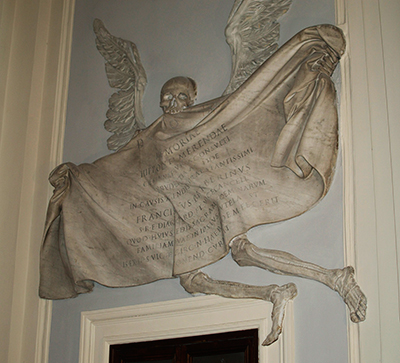 Buy Art Prints Now
Buy Art Prints Nowfrom Amazon
* As an Amazon Associate, and partner with Google Adsense and Ezoic, I earn from qualifying purchases.
Ippolito Merenda Memorial is a funerary monument that was designed by a famous artist from Italy who was known by the name Gian Bernini Lorenzo. This monument was created between the year 1636 and 1638.
This artwork from Gian Lorenzo was the starting point for a new approach to monuments for funerals which incorporated dynamic and flowing inscriptions that have been dragged by a moving dead figure. Merenda came from Cesena. He left a legacy on his death in the year 1636. After his death, one of his nephews commissioned the monument from Bernini as recognition for Merenda’s contribution in different fields in Italy.
This sculpture is situated inside S. Giacomo Lungara church. Ippolito's memorial is positioned upstairs a doorway along the wall on your right hand on the way to the main altar. This memorial, a white marble reprieve is made up of a skeleton, which is winged and is grasping a fictive cloth with its fingers and teeth. The skull and the margins are the only evident parts of the skeleton while the other parts are concealed behind the drapes. The extended wings of the frame indicate its ascent, while its bases anchors to the architecture. At the centre of the cloth, there seems to float an undated inscription which follows the folds.
The undated inscription is related to the memorial of Alessandro Vilttrini, which is also found on the hedge, just directly at the right hand as you enter the church. This sculpture was designed by Bernini, who was mainly inspired by Gian. Bernini was later executed by his workshop. This memorial by Bernini comprises a low-relief, marble bust of Valtrini which are seen in the three-sector view and is surrounded by and decorative oval border. He looks a reprieve as of a feathered skeleton which in turn seems to stare at people who are entering the church.
The sculpture embraces the portrait on its right hand, and it directs its left hand’s index figure directly into the frame of the relief. The structure, portrait and the skeleton are all made of the similar marble which is white. These marbles seem to be diagonally drifting upwards.
Born and raised in Naples, Gian is considered as the most celebrated sculptor of the 17th century by many people. He was guided through the sculpting work by his father and later on, he became an inspiring person to many sculptors in Italy and the rest of the world. He started this work at an early age, and he perfected his art through working for the popes who were constructing lavish churches and other monuments. He got a chance to work for them, and his work always stood out from the rest.
Due to his vision, he managed to server for the popes for 20years where he always tried to capture any fleeting moments before or during speeches and he would work on them and brought them to life. Before his death, he had created the most memorable and beautiful sculptures and monuments in Italy. He made Rome be known as an Open air museum due to his fountains.




